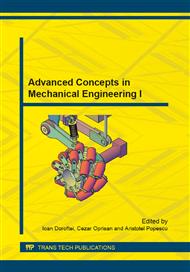p.371
p.377
p.381
p.389
p.395
p.401
p.407
p.413
p.417
Some Aspects Concerning Modeling the Eye Plant without Ocular Deviations
Abstract:
Oculomotor plant and saccade generator are the basics of the saccadic system. The purpose of this paper is mainly focused on mathematical models of horizontal eye movement system. In this respect, it is presented a model for the mechanics of horizontal eye movement. The oculomotor system is presented incorporates known physiological dynamics and musculotendon complex geometry. Developing muscle strength can be described by a two-component version of the model Hill and consists of a passive and active contractile component. The active component includes force-velocity and force-length characteristics of the muscle. Passive component accounts for elastic and viscous effects. Couple neuronal activation dynamics controls that is appropriate for judder from muscle mechanics.
Info:
Periodical:
Pages:
395-400
Citation:
Online since:
October 2014
Authors:
Keywords:
Price:
Сopyright:
© 2014 Trans Tech Publications Ltd. All Rights Reserved
Share:
Citation:


